Beyond borders
How automation transforms cross-border e-commerce for logistics, retail, and delivery
In the fast-paced world of e-commerce, crossborder trade has become the new standard. Yet for many parcel carriers, logistics providers, and retailers, one critical process still lags behind: customs clearance. Manual workflows, inconsistent data, and evolving regulations create friction that slows shipments and adds risk.
We explore how automation can turn customs from a bottleneck into a strategic advantage. You’ll discover the most common challenges e-commerce businesses face, what’s required to enable automation, and how digital tools can dramatically simplify compliance and clearance processes. Real-world examples, actionable steps, and expert insights will guide you through the journey. If your business ships across borders, this is a must-read.
The pressure to evolve
Why manual customs processes are no longer viable
- Regulation changes
Global trade evolution - Slow processing
Manual processes are slow - Increased errors
Incorrect data halts shipments - Customer dissatisfaction
Delays and fines impact customers
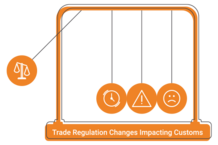
The shift in global trade and regulation
Cross-border e-commerce has become a cornerstone of international trade, contributing to a global trade volume of over USD 31 trillion in 2023. However, customs frameworks have not remained static. On the contrary, the EU alone introduced over 450 changes to customs regulations within just three years. This constant evolution puts immense pressure on companies to remain compliant while maintaining speed and efficiency.
Manual customs processing is ill-equipped to handle these demands. These processes are slow, labor-intensive, and highly error-prone. A single incorrect HS code or missing field can halt a shipment at the border, potentially leading to fines, delays, and dissatisfied customers. For logistics service providers (LSPs), retailers, and parcel carriers, outdated customs procedures are increasingly a liability.
The digital imperative
To meet the demands of modern e-commerce, automation has shifted from a competitive advantage to a necessity. Since the introduction of the EU Union Customs Code in 2016, electronic customs declarations have become the new norm. Now, with the EU Customs Reform Package of 2023, the focus is on a fully data-driven customs ecosystem. Companies that cling to manual processes risk falling behind, while those embracing automation gain not only in compliance and efficiency but also in customer satisfaction.
Cross-border friction
What’s holding back logistics, retailers, and carriers
Administrative overload
Manual data entry remains a significant time sink in e-commerce customs operations. In many companies, customs staff must enter the same shipment information into multiple systems, sometimes even duplicating it for different national customs platforms. This redundancy not only wastes valuable hours but also opens the door to costly mistakes. Studies show that manual data entry can result in error rates of up to 4% in complex cases, compared to near-zero rates in automated systems.
System fragmentation
Many logistics operations rely on a patchwork of legacy systems — WMS, ERP, TMS — that were never designed to work together. The result is frequent “media breaks,” where data must be transferred manually from one system to another. These handovers are not only inefficient but also introduce risks of inconsistency and data loss. Integration gaps hinder the visibility of customs-relevant data, delaying declarations and increasing compliance risks.
Compliance complexity
Customs for e-commerce is not a one-size-fitsall process. Each country has its own tariffs, classifications, and regulatory frameworks. For e-commerce retailers and carriers operating internationally, staying up to date on changing embargoes, sanctions, and thresholds is a constant challenge. Missing even a minor regulatory update can result in shipment holds, f inancial penalties, or even legal consequences. Without automation and real-time validation, companies struggle to keep up.
Cross-border friction in logistics and retail
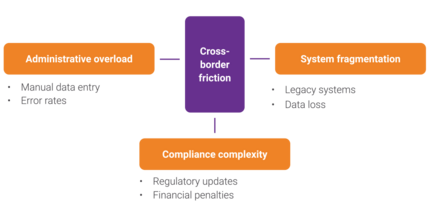
Building the foundation
What companies need before they automate
System readiness
Automation technologies need robust infrastructure to work effectively. APIs and Electronic Data Interchange (EDI) interfaces are essential for enabling seamless communication between order management systems, warehouse tools, and customs solutions. Without system interoperability, even the most advanced customs solution becomes a digital island.
A centralized data strategy
One of the most critical prerequisites for e-commerce customs automation is the availability of clean, centralized, and structured data. Companies must adopt a Single Source of Truth (SSOT) principle. This means maintaining a unified database for all product master data, customer details, and customs-relevant information. When this data is spread across spreadsheets, departments, or disconnected tools, the potential for inconsistency is high — and automation suffers.
Organizational alignment
Technology alone cannot solve e-commerce customs challenges. Cross-functional collaboration is required across departments. From product data managers to logistics coordinators and IT teams, all stakeholders must understand the automation roadmap. Moreover, data ownership must be clearly assigned. When everyone understands their role in data governance, automation can scale smoothly.
Preparing for customs automation
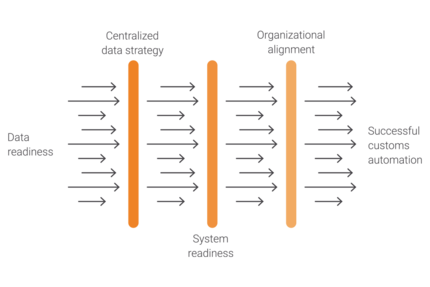
What automation looks like
From software robots to smart validation
Process automation
Process automation is the backbone of many modern customs solutions. Automation software can operate around the clock, automatically performing tasks that would typically require manual input — such as reading commercial invoices, extracting data, filling in customs forms, and submitting declarations. Because process automation follows predefined rules without deviation or fatigue, it eliminates human error in repetitive workflows. According to McKinsey, such automation can reduce customs processing time by up to 50%. Depending on the process, it can go as high as over 90%.
Smart validation
In addition to task automation, advanced systems offer built-in validation engines. These tools check each customs entry for completeness, correctness, and compliance — flagging issues like missing mandatory f ields, incorrect HS codes, or outdated tariff information before submission. This preemptive approach prevents rejections, reduces delays at borders, and ensures consistency with regulatory updates. By automating checks, e-commerce companies can ensure they meet national and international customs requirements proactively.
Seamless integration
True automation is only possible when systems communicate. Leading customs platforms offer seamless integration with WMS, TMS, and ERP systems via APIs or EDI. This interconnectivity ensures that shipment and order data can be reused across platforms without duplication or manual transfer. Integration allows for real-time visibility and end-to-end data f low, creating a digital thread from order to delivery. For logistics providers and retailers, this reduces administrative overhead and ensures that the customs declaration is always aligned with upstream business processes.
The automation advantage
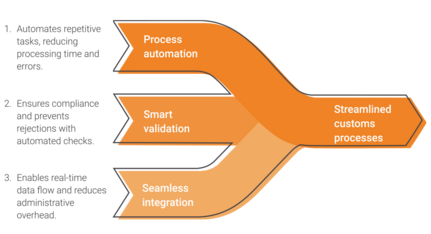
Unlocking the benefits
Why automating customs pays off
Faster processing
Manual customs processes in e-commerce can take days to complete — especially when errors or incomplete documentation cause delays. With automation, these same processes can be completed in minutes. Case studies have shown that companies like Pro Carrier or DHL achieved a 40% improvement in customs clearance speed after implementing automation. Faster processing results in quicker deliveries, happier customers, and fewer disruptions in the supply chain.
Fewer errors
Automation dramatically reduces the rate of human error. While manual data entry has an error rate between 1–4%, automated systems often achieve accuracy rates exceeding 99.9%. This not only prevents shipment holds but also avoids the reputational damage associated with recurring customs issues.
Better compliance
Customs automation for e-commerce supports compliance by embedding current rules and validation logic into the system. Changes to duty rates, embargoes, or documentation requirements can be updated centrally and distributed automatically. This eliminates the need for staff to stay manually up to date on regulatory changes and significantly reduces the risk of non-compliance.
Higher efficiency and cost savings
Beyond speed and accuracy, automation improves resource allocation. Staff are relieved from repetitive administrative tasks and can focus on value-adding activities. It also reduces indirect costs, such as those caused by delays, f ines, or customer churn. The result is a leaner, more agile customs operation that scales with business growth.
Data as the fuel
The critical role of information in automated customs
Data quality drives automation
Customs automation can only be as effective as the data behind it. If shipment information, product classifications, or customer data are incorrect or inconsistent, even the most advanced automation tools will fail. High-quality data ensures reliable customs declarations, accurate tariff applications, and consistent compliance with rules.
Mapping and enrichment
One best practice in automation implementation is intelligent data mapping. This process involves connecting data fields from various systems — such as ERPs, WMSs, or TMSs — and ensuring that relevant customs data is correctly formatted and transmitted. Enrichment tools help fill in missing data, validate codes, and crosscheck inputs against official lists (e.g., tariff databases or embargo registries). This level of automation prevents manual errors and boosts confidence in regulatory accuracy.
The future: central data hubs
The EU’s forthcoming Customs Data Hub will enable e-commerce companies to submit shipment and product data once and use it for all customs declarations across Member States. This vision illustrates how centralizing data not only supports automation but also reduces redundancies and regulatory friction across borders. Businesses that prepare their systems and data strategies now will be better positioned to integrate with such infrastructure.
The data-driven customs revolution
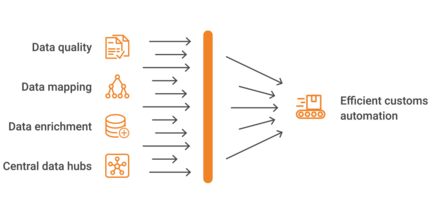
How leaders succeed
Implementation of best practices and lessons learned
Start small
A successful automation journey often begins with a focused pilot project. Companies may choose a specific product category, trade route, or country for their pilot. This approach minimizes risk while demonstrating value quickly. It also provides valuable learning before scaling the solution across the broader organization.
Choose the right partner
The customs software landscape is vast. When selecting a technology partner, companies should evaluate functionality, regulatory coverage, integration capability, and scalability. Suitable providers for e-commerce needs will demonstrate success in handling complex, multi-country customs processes. Look for partners who understand your industry and offer real-time support, clear implementation roadmaps, and transparent compliance tracking.
Prepare your team
Technology is only part of the solution. Employees need to be trained not just on using the software, but also on understanding how their workflows will change. Change management is essential. Successful projects often involve early adopters and internal champions who help promote acceptance across departments. Strong stakeholder engagement and open communication help ensure a smooth transition.
First movers win
Real-world examples of successful automation
Pro Carrier: improved inspection rate
Pro Carrier relied on automated customs processes to bring down its inspection rate of about 30%. Digitized data exchange with customs brokers prevents manual errors and provides transparency for the entire cross-border journey. The successful integration of software for automated processes brought the inspection rate down to below 1%.
DHL: RPA success
DHL used robotic process automation to digitize its customs documentation, resulting in a 40% reduction in processing time and a marked decrease in manual errors. This success story highlights how automation can create immediate operational improvements and longterm scalability.
ECC: scalable automation
ECC launched its customs automation initiative with a pilot project in one business unit. Based on early successes, the company gradually expanded automation to multiple countries and processes. This stepwise approach helped ECC build confidence, train staff incrementally, and optimize integration with minimal disruption.
DPD: data enrichment for returns
For return shipments, customs compliance can be especially complex. DPD implemented an automated solution to enrich return shipment data in real time, ensuring correct HS codes and values are included from the start. This streamlined their return process, improved traceability, and enhanced the customer experience.
Successful automation strategies
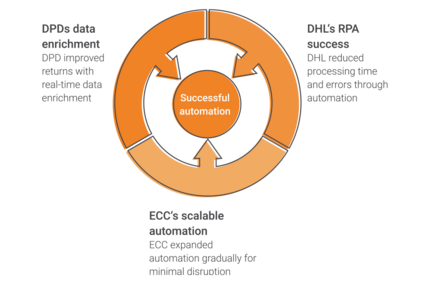
The roadmap to action
How to get started now
Assess your current customs processes
A thorough analysis of current customs workflows is the first step. Identify where manual tasks dominate, where errors most frequently occur, and where delays are costing time and money.
Define your goals
Different businesses have different priorities: some want to speed up deliveries, others focus on regulatory compliance or cost efficiency. Understanding your core objectives will help shape your automation strategy and set the right KPIs.
Build a business case
Automation requires investment. To secure stakeholder support, build a strong business case with clear ROI projections. Include time savings, error reduction, and operational improvements in your calculation.
Plan your pilot
Design a manageable pilot project with clear scope, timeline, and metrics. Choose a use case that is representative enough to provide insight but contained enough to control risks. Use the pilot as a learning opportunity to refine your broader rollout.
Project roadmap to customs automation
2. Define goals Determine specific objectives such as speed or compliance
3. Build business case Develop a strong justification for automation investment
4. Plan pilot project Design a manageable pilot to test automation strategies

Conclusion
From bottleneck to competitive edge
Customs automation in e-commerce is no longer optional — it’s a strategic lever for agility, growth, and compliance. Companies that embrace automation gain not only faster and more accurate customs processes, but also a solid foundation for scaling their cross-border operations.
Looking ahead, the future of customs is increasingly digital and connected. Initiatives like the EU Customs Data Hub signal a shift toward centralized, onetime data submission across Member States. We can also expect growing integration between logistics platforms, government systems, and trade partners through APIs and real-time data exchanges. Artificial intelligence will further enhance classification, validation, and risk detection capabilities.
Businesses that invest in automation today will be best equipped to navigate tomorrow’s regulatory landscape, customer expectations, and competitive pressures. The journey begins with a single step — now is the time to take it.

